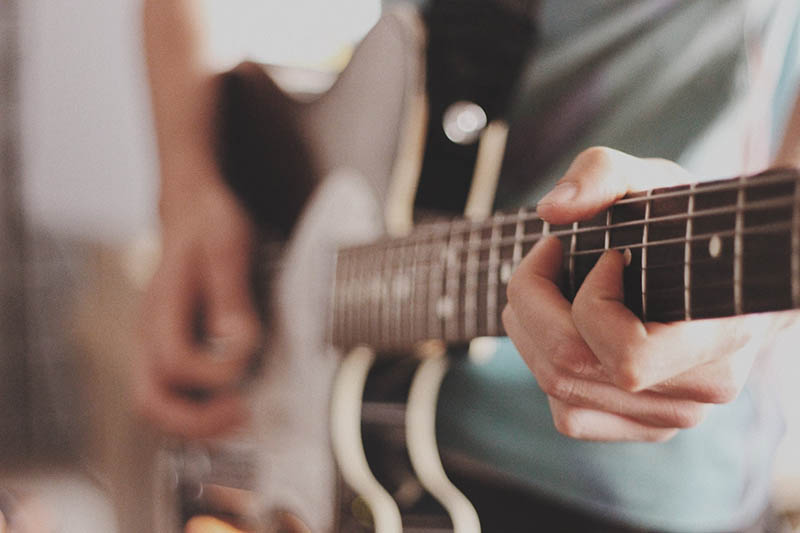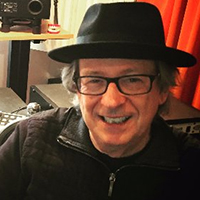Because of its fundamental importance in popular music, the electric guitar is the subject of intense scrutiny and wide differences of opinions. Just what makes a good guitar sound? Compared to all the subtle and not so subtle sounds that come out of an electric guitar amp, fidelity judgments of vocal sounds are easy to make!
With good knowledge of the different guitar and amplifier sonic capabilities, coupled with good microphone techniques,we can achieve the ultimate guitar sound that “fits” the guitar part, song and production genre.
A good guitar sound starts with a good player with the right amp and guitar all working together. It’s unrealistic to rely on an engineer to make poor gear sound wonderful in the control room. Microphone choices and miking techniques are good starting points for capturing and recording electric guitar amp sound.
Microphone Selection
Microphone choice (for me) is as big a part of the guitar amp’s recorded sound as the amp and guitar used, volume played and player choice, because the mic type and placement will greatly influence the player’s performance and tone.
Dynamic Models
The Shure SM57 cardioid dynamic is the most common microphone used to record electric guitar. This started back when all the more expensive microphones had already been used in big tracking sessions. Engineers were left with the “lowly” SM57 to handle those loud, cranky, noisy guitar amps.
But it turns out that the SM57 is perfect for the task; its frequency response, originally tailored for speaking, matches the mid-range “voice” qualities of the guitar. Italso has a compression effect on loud sounds – it squashes nicely, facilitating the engineer’s job of maintaining consistent recording levels.
You’ll see engineers push a SM57 right into the grill cloth of an amp cabinet, taking advantage of the proximity effect, which boosts low frequencies when the mic is placed close to a sound source. The SM57 locks in a certain “size” for the electric guitar, maintaining its appropriate place in the mix without additional EQ or compression.
The Sennheiser MD 421U cardioid dynamic is also popular, offering a wider frequency response (more high and low frequencies) than the SM57. A five-position rotary switch adjusts the frequency response from the flat position, called M (for music), all the way to the contoured S (for speech).
Generally, I find the 421 brighter with less of the compression effect than the SM57. These mics are also more directional, which is important for isolating the sound coming from one speaker in a multi-speaker cabinet.
Condenser Models
Condenser microphones also work great, but care must to taken to not get an overly bright sound. Your guitar player might complain that his amp sounds brighter than usual (compared to a SM57) and feel he must readjust his recording knob settings. As a result, I place them further away from the speakers.
Figure 1 shows a Shure KSM44 condenser about 20 inches from a 1960s vintage straight Marshall 4X10 cab. (I was auditioning the three cabinets in the picture).

Condensers pick up more low frequencies from the amp, and this may or may not be a good thing. Pushing a lot of air might work in a heavy metal track, but it also might be inappropriate for a lighter pop song.
I’ve also noticed certain condensers sometimes add distortion when close-miking extremely loud amps. Occasionally, the metal wind screen can get loose and vibrates. Always use the attenuator pad and maybe the low frequency roll-off. The Neumann U 87 and U-47FET, Shure KSM44 and Audio-Technica AT4041 are all good choices.
Condenser microphones also provide the opportunity to experiment with different polar patterns such as omnidirectional and Figure-of-Eight (see my article about this here). Omnidirectional mics do not exhibit the proximity effect and will pick up more of the total sound of the amp and room tone, rather than one particular speaker. I like omni mics for more of an ambient guitar sound or for room mics. Figure-of-Eight mics also pick up more of the room, but only from directly behind the mic’s body opposite the front side.
Speaking of Figure-of-Eight, one of my favorites for guitar is the ribbon microphone. I have a pair of Royer R-121 Figure-of-Eight microphones that offer a whole new range of warm electric guitar sounds.
Big, cumbersome and old ribbon mics have been around for years, but using them on loud instruments carried the fear of knocking the fragile ribbon element off their suspension mounts. The smaller, lighter Royer mics can handle huge volumes without the worry.
One engineer remarked to me,“when you switch from the Royer back to the 57, you wonder where half the guitar sound went.” Granted, a big, fat and warm guitar sound on its own might sound ideal, but does it fit into your song production?
The Royer mic picks up sound from two opposing sides in what is also called a bi-directional pattern, and you can take advantage of this to get more of the recording space (room) in the sound. Sound entering the rear of the mic is 180 degrees out-of-phase with that coming into the front.
Placement
Various mic placements on guitar amps are closely guarded trade secrets among recording engineers, but here are some tried and true methods that’ll make good starting positions.
From The Front
Figure 2 shows an SM57 pointed at a very rare 1960s Gibson recording amp. I aim the microphone exactly at the center of the speaker driver inside the amp. (For those who don’t know this amp, the speaker is not mounted in the exact center of the cabinet, but I’m acting as though it is).
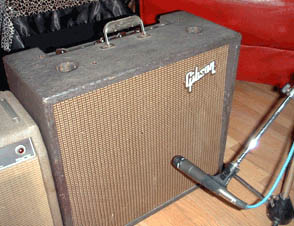
To facilitate seeing through the grille cloth, use a flashlight. This position produces the most high frequencies and moving the mic closer increase both level, low frequencies and reduces the cabinet’s contribution to the overall sound.
Some guitarists and engineers say there is nothing coming out of the exact center of a speaker that’s worth recording. (I could make a funny retort here too easily.) This is true for certain speakers, but test this position yourself to judge its usefulness.
If you want less highs and more warmth, move the mic sideways, parallel to the floor, toward the outside of the speaker. Move in 1-inch increments, with someone in the control room you trust listening for sound changes. With a mic positioned inches from a speaker cone, small increments make a big difference.
At An Angle
Figure 3 shows an SM57 at a slight angle on a Fender Brown-Face Deluxe. I find this a better position most of the time since you seem to get plenty of highs and more tonality than straight on.
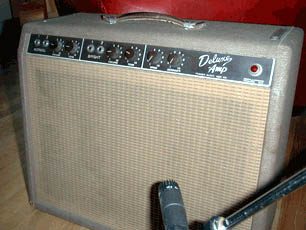
It’s a good idea to try from both sides and from the top or bottom. If the mic ends up on the floor pointed at the speaker, and sounds good, nail it down! The floor is going to trap bass frequencies and also add tone especially if it is made of wood and is built on a raised foundation.
Tilt The Amp
If the floor seems to “close down the sound,” try tilting the amp back. Fenders have chrome legs on the sides of the cabinets for that purpose, and it also projects the sound up at the musician.
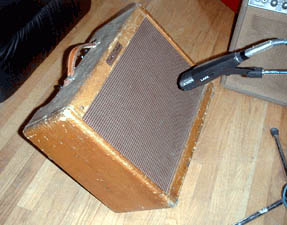
VOX amplifiers, like the AC30 and Super Beatles models, come with tilting carriage stands that completely isolated the amplifier from the floor. If possible, I like to set the amp on a folding chair. Figure 4 shows an MD 421U on a vintage Fender Tweed Deluxe. Here, the amp is tilted back so that the bottom of the amp’s cabinet couples less with the floor.
All of these amps are open-backed, so a wall or open space directly behind them greatly affects bass response.
Front & Back
Figure 5 shows an open-backed amp, the Matchless DC30, with an SM57 on the rear and a KSM44 on the front. This set-up produces a very unusual tone and allows mixing the two mics for a mono track or using two tracks placed left and right in the mix. The phase of one of the mics should be flipped.
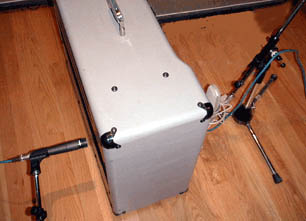
Try moving the mics very close to the speakers and processing the rear mic through a very short delay — less than 3 ms (milliseconds). Also, try NOT flipping phase.


